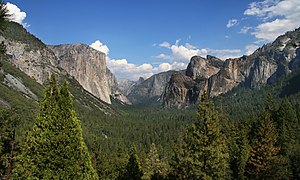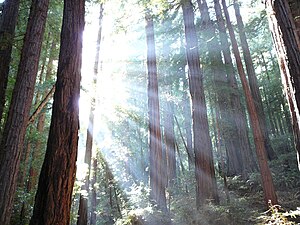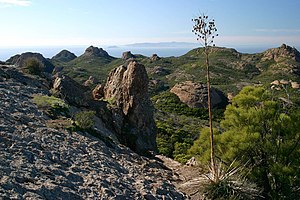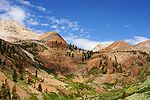Protected areas of California
Obtaining an accurate total of all protected land in California and elsewhere is a complex task. Many parcels have
National Park System
The U.S.
National parks |
 |
National monuments(administered by the NPS)
|
 |
National recreation areas
|
 |
National seashores |
 |
National preserves |
 |
National Landscape Conservation System
The Bureau of Land Management’s National Landscape Conservation System (NLCS) includes over 850 federally recognized areas and in California, manages 15,500,000 acres (63,000 km2) of public lands, nearly 15% of the state's land area.[3] The National Landscape Conservation System is composed of several types of units: national monuments (distinct from the same-named units within the National Park System), national conservation areas, forest reserves, outstanding natural areas, national scenic and historic trails, wilderness, wilderness study areas, and others.
National monuments(administered by the BLM)
|
 |
National conservation areas
|
 |
Forest reserves
|
Headwaters Forest |
Outstanding natural areas
|
Piedras Blancas Historic Light Station |
National scenic and historic trails
|
 |
Wilderness and wilderness study areasTotal BLM-managed wilderness land in California is 3,725,230 acres (15,075.5 km2).[4] |
 |
National Marine Sanctuaries

The National Marine Sanctuary System is managed by the Office of Marine Sanctuaries, of the National Oceanic and Atmospheric Administration.
California has four of the thirteen U.S. National Marine Sanctuaries:
- Channel Islands National Marine Sanctuary
- Cordell Bank National Marine Sanctuary
- Gulf of the Farallones National Marine Sanctuary
- Monterey Bay National Marine Sanctuary - one of the largest in the world at 5,300 square miles (14,000 km2).[5]
National Wildlife Refuges
National Wildlife Refuge (NWR) is a designation for certain protected areas of the United States managed by the United States Fish and Wildlife Service. The National Wildlife Refuge System is an extensive system of public lands and waters set aside to conserve America's fish, wildlife and plants. Many of the state's refuges are important stops and destinations for millions of migrating birds along the Pacific Flyway corridor. One, the Butte Sink Wildlife Management Area, has the highest density of waterfowl in the world.[6] There are 38 units in the refuge system in California, including both wildlife refuges and wildlife management areas, divided into 9 different regional areas. Combined the areas equal about 440,000 acres (1,800 km2).
Hopper Mountain NWR Complex |
 |
San Diego NWR Complex |
 |
Humboldt Bay NWR Complex |
San Francisco Bay NWR Complex
|
 | |
Kern NWR Complex |
 |
San Luis NWR Complex |
 |
Klamath Basin NWR Complex |
 |
Sonny Bono Salton Sea NWR Complex |
 |
Sacramento NWR Complex |
Sacramento National Wildlife Refuge |
Other refuges |
 |
Wild and Scenic rivers
Rivers designated as Wild and Scenic are administered by one of four federal land management agencies: The Bureau of Land Management, The National Park Service, The U.S. Fish and Wildlife Service or The U.S. Forest Service.[7] There are 22 rivers in California with portions designated as Wild and Scenic, with 23 designations in all (the American River has two separate designations, one for the North Fork, and one for the Lower section).[8] Listed in miles.
| River | Designated Wild | Designated Scenic | Designated Recreational | Total Protected |
|---|---|---|---|---|
| Amargosa River | 7.9 | 12.1 | 6.3 | 26.3 |
| American River (Lower) | 23 | 23 | ||
| American River (North Fork) | 38.3 | 38.3 | ||
| Bautista Creek | 9.8 | 9.8 | ||
| Big Sur | 19.5 | 19.5 | ||
| Black Butte River | 17.5 | 3.5 | 21 | |
| Cottonwood Creek | 17.4 | 4.1 | 21.5 | |
| Eel River | 97 | 28 | 273 | 398 |
| Feather River | 32.9 | 9.7 | 35 | 77.6 |
| Fuller Mill Creek | 2.6 | 0.9 | 3.5 | |
| Kern River | 123.1 | 7 | 20.9 | 151 |
| Kings River | 65.5 | 15.5 | 81 | |
| Klamath River | 11.7 | 23.5 | 250.8 | 286 |
| Merced River | 71 | 16 | 35.5 | 122.5 |
| Owens River | 6.3 | 6.6 | 6.2 | 19.1 |
| Palm Canyon Creek | 8.1 | 8.1 | ||
| Piru Creek | 4.3 | 3 | 7.3 | |
| San Jacinto River (North Fork) | 7.2 | 2.3 | 0.7 | 10.2 |
| Sisquoc River | 33 | 33 | ||
| Smith River | 78 | 31 | 216.4 | 325.4 |
| Trinity River | 44 | 39 | 120 | 203 |
| Tuolumne River | 47 | 23 | 13 | 83 |
National Wilderness Preservation System
| There are 149 wilderness areas in California totaling just over 15,000,000 acres (61,000 km2). US Fish and Wildlife Service and the National Park Service . Rarely, if ever, are designated wilderness areas stand alone protected areas, and thus their areas are, in all likelihood, already accounted for in the various agencies' inventories.
|
 |
National Forests
California has 17 U.S. National Forests, one special management unit (

| State Forest | Land area (in acres) |
|---|---|
| Angeles National Forest | 655,387 |
| Cleveland National Forest | 460,000 |
| Eldorado National Forest | 596,724 |
Humboldt-Toiyabe National Forest
|
6,289,821 |
| Inyo National Forest | 1,903,381 |
| Klamath National Forest | 1,737,774 |
| Lassen National Forest | 1,070,344 |
| Lake Tahoe Basin Management Unit | 150,000 |
| Los Padres National Forest | 1,950,000 |
| Mendocino National Forest | 913,306 |
| Modoc National Forest | 1,654,392 |
| Plumas National Forest | 1,146,000 |
| San Bernardino National Forest | 823,816 |
| Sequoia National Forest | 1,193,315 |
| Shasta–Trinity National Forest | 2,209,832 |
| Sierra National Forest | 1,300,000 |
| Six Rivers National Forest | 957,590 |
| Stanislaus National Forest | 898,099 |
State Forests
The California Department of Forestry and Fire Protection (CAL FIRE) operates eight Demonstration State Forests totaling 71,000 acres. The forests represent the most common forest types in the state. The State Forests grow approximately 75 million board feet of timber annually and harvest an average of 30 million board feet each year, enough to build 3,000 single-family homes. Revenue from these harvests fund the management of the State Forests. In addition, the forests provide research and demonstration opportunities for natural resource management, while providing public recreation opportunities, fish and wildlife habitat, and watershed protection. Activities include: experimental timber harvesting techniques, watershed restoration, mushroom collecting, hunting, firewood gathering, cone collecting for seed, a variety of university research projects, horseback riding, camping, mountain biking, and hiking.[10]

| State Forest | Land area (in acres) | County | City |
|---|---|---|---|
| Boggs Mountain Demonstration State Forest | 3,493 | Lake | Cobb |
| Ellen Pickett State Forest | 160 | Trinity | |
| Jackson Demonstration State Forest | 50,195 | Mendocino | Fort Bragg |
| Las Posadas State Forest | 796 | Napa | Angwin |
| LaTour Demonstration State Forest | 9,003 | Shasta | Redding |
| Mountain Home Demonstration State Forest | 4,807 | Tulare | Springville |
| Mount Zion Demonstration State Forest | 164 | Amador | |
| Soquel Demonstration State Forest | 2,681 | Santa Cruz | Soquel |
State parks
| The Los Angeles Cultural Affairs Department,[12] is a mere 0.1-acre (400 m2).
|
 |
State wilderness areas
Additionally, 386,000 acres (1,560 km2) of Anza-Borrego State Park have been designated as wilderness.[14]
|
 |
Department of Fish and Wildlife Protected Areas
|
The California Department of Fish and Wildlife (DFW), through its seven regional divisions,[15] manages more than 700 protected areas statewide, totaling 1,177,180 acres (4,763.9 km2).[16] They are broadly categorized as: |
 |
Municipal parks
| Most cities and counties in California, as in elsewhere, own and operate open spaces of various types, the most recognizable being the city and county park. By far the largest inventory of protected land held by a municipal agency belongs to the Los Angeles Department of Water and Power, with just over 400,000 acres (1,600 km2) in its jurisdiction.[19] The largest city park in the state is Mission Trails Regional Park in San Diego at 5,800 acres (23 km2), although there are several county and regional parks that are larger. Total land owned by municipal agencies is roughly 1,500,000 acres (6,100 km2) acres. |  |
Privately owned preserves
|
In addition to the many public lands are about 550,000 acres (2,200 km2) of privately owned preserves. Sempervirens Fund, the Sacramento Valley Conservancy and the Wilderness Land Trust .
|
 |
Largest land owners of protected lands
The 20 largest landholders, according to the CPAD 2018a Statistics Report:
| Agency | Total lands owned (in acres)* |
|
U.S. Forest Service |
20,758,417 |
| *These numbers may not correspond exactly with those reported directly from the agencies. | |
References
- ^ "California Protected Areas Data Portal". www.calands.org. Retrieved 8 April 2018.
- ^ "NPS Public Use Statistics Office: Acreage Reports". National Park Service. Retrieved 2010-04-22.
- ^ http://www.blm.gov/ca/st/en.html BLM-California website.
- ^ BLM California data page. Archived 2009-01-11 at the Wayback Machine
- ^ Administration, US Department of Commerce, National Oceanic and Atmospheric. "NOAA's National Ocean Service: National Marine Sanctuaries". oceanservice.noaa.gov. Retrieved 8 April 2018.
{{cite web}}: CS1 maint: multiple names: authors list (link) - ^ "Butte Sink Wildlife Management Area". U.S. Fish & Wildlife Service. Archived from the original on 2010-05-22. Retrieved 2010-04-24.
- ^ "Interagency Wild & Scenic Rivers Council". Wild & Scenic Rivers Council. Archived from the original on 2010-06-10. Retrieved 2010-04-21.
- ^ "California". National Wild and Scenic River System. Retrieved 2017-05-07.
- ^ "Wilderness areas in California". Archived from the original on 2010-06-12. Retrieved 2009-10-03.
- ^ "Cal Fire Demonstration State Forests".
- ^ "A State Park System is Born". California State Parks. Retrieved 2007-10-07.
- ^ "Watts Towers of Simon Rodia SHP". California State Parks. Retrieved 2010-05-17.
- ^ "State Parks Along California's North Coast Redwoods and History" (PDF). California Department of Parks and Recreation.
- ^ "State Designated Wilderness Programs in the United States" (PDF). International Journal of Wilderness. Archived from the original (PDF) on 2010-07-10. Retrieved 2010-04-24.
- ^ "DFW Regions". California Department of Fish and Wildlife (DFG) website. Retrieved 2008-02-19.
- ^ "Lands Inventory Fact Sheet". California DFG website. Retrieved 2008-02-19.
- ^ "Wildlife Areas". California DFW website. Retrieved 2008-02-19.
- ^ "Ecological Reserves". California DFW website. Retrieved 2008-02-19.
- ^ "CPAD Release notes". GreenInfo Network. Archived from the original on 2010-05-14. Retrieved 2010-05-17.
- ^ "The Nature Conservancy in California". The Nature Conservancy. Archived from the original on 2011-03-01. Retrieved 2010-04-24.
- ^ "Wind Wolves Preserve". Wildlands Conservancy. Archived from the original on 2016-03-02. Retrieved 2016-09-07.
- ^ "California Member Land Trusts". The California Council of Land Trusts. Retrieved 2016-09-07.
